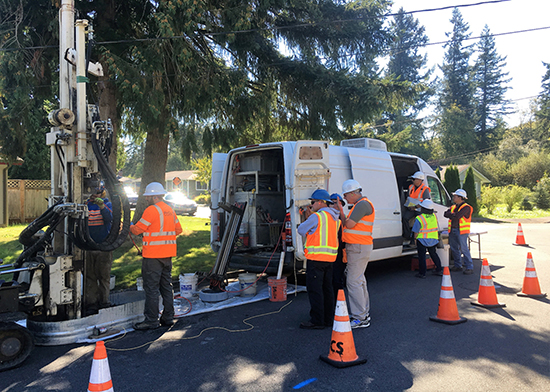|
Subscribe / Renew |
|
|
Contact Us |
|
| ► Subscribe to our Free Weekly Newsletter | |
| home | Welcome, sign in or click here to subscribe. | login |
Construction
| |
 |
January 22, 2018
Best in State: Gold Award
Successful Fulfillment of Client/Owner Needs
GeoEngineers

Project: Palermo data gaps and feasibility study
Client: Washington State Department of Transportation
When the Washington State Department of Transportation was identified as a potentially liable party in the cleanup of a chemically contaminated site in Tumwater, they turned to GeoEngineers to help them understand the full extent of the problem.
As the prime environmental consultant on the job, GeoEngineers used creative solutions and adaptive technologies that ultimately shaved years off the schedule and reduced investigative costs by half.
Back in the 1990s, routine testing identified industrial solvents in groundwater in the Palermo Wellfield. Because the chemicals were affecting drinking water and the extent of contamination was so widespread, the area around the wellfield qualified as a federal Superfund site.
The Environmental Protection Agency addressed immediate concerns, but its solution was not completely effective in mitigating site contamination.
Contaminated groundwater has since migrated to the Palermo neighborhood, a group of approximately 50 homes in Tumwater below a steep bluff.
WSDOT contracted with GeoEngineers to provide a “data gaps” analysis so the agency could fully understand the scope of the issue. Additional consultants included Columbia Technologies, Holt Services and Eurofins Air Toxics.
GeoEngineers’ work also included an extensive air-monitoring program to determine if vapor intrusion in the homes was a problem. Both jobs used new technology and creative solutions to address the issues. The results of these efforts have changed the practice of environmental investigations by validating new technologies and building confidence with the EPA.
To identify the extent of the contamination, GeoEngineers needed an approach that could collect subsurface data in a rapid, efficient and cost-effective manner. A conventional drilling, sampling and analysis program could narrow the data gaps, but it would be time consuming and expensive.
GeoEngineers determined that membrane interface probe (MIP) direct sensing technology would allow them to collect a large amount of information that could be applied flexibly across the site. The team tracked low-level solvent contamination across an approximately half-square-mile area — the largest known area ever evaluated using an MIP device in EPA Region 10 (comprising Alaska, Washington, Oregon and Idaho). This approach enabled GeoEngineers to pinpoint the exact location of contamination and make adaptive field decisions in a timely manner.
The air monitoring program sought to determine whether vapor intrusion was still occurring in the nearby homes — something the EPA had confirmed early on in their investigation. Initial air sampling showed lower-than-anticipated levels, so it was determined that the best way to test for vapor intrusion would be a simulated worst-case scenario.
GeoEngineers rented a vacant home in the part of the neighborhood known to have to highest historic contamination concentrations and conducted two separate worst-case scenario tests in the home during two different seasons. Tests involved reducing indoor air pressure by sealing the openings in the home and using industrial fans to vent to the exterior. Results showed vapor concentrations to not be an immediate concern.
GeoEngineers’ contributions to the project allayed concerns about air quality in homes and provided actionable information to WSDOT. The detail of the findings enabled remediation to be correctly scaled to match the need, thereby reducing costs to taxpayers and minimizing impact on the affected community.
The exploration program was completed in one year and cost $1.5 million, as opposed to three years at a cost of $3 million for a traditional exploration program.
Other Stories:
- National finalist: Platinum Award
Structural Systems
Magnusson Klemencic Associates - National finalist: Gold award
Structural Systems
COWI North America - National finalist: Gold award
Special Projects
Hart Crowser - National finalist: Gold award
Special Projects
Parsons - Best in State: Gold Award
Unique or Innovative Applications
Golder Associates - Best in State: Gold Award
Social, Economic and Sustainable Design
J-U-B Engineers - Best in State: Gold Award
Future Value to Engineering Profession
MIG/SvR - Best in State: Gold Award
Complexity
Stantec - Engineer of the Year


